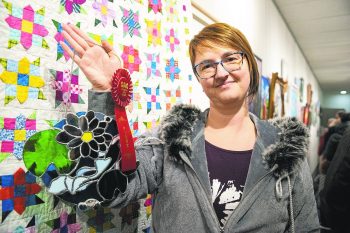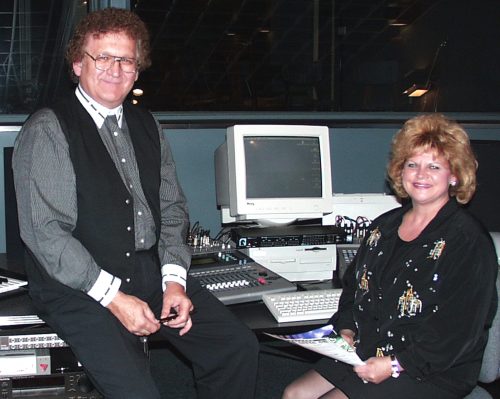Homepage
Southeast Open Judged Art Exhibit returning after successful run in 2024
3 minute read 5:57 PM CSTThe Southeast Open Judged Art Exhibit (SOJE) is returning after a successful year of showings in 2024 where the Steinbach Arts Council (SAC) recorded a 30 percent increase in submissions.
“(The reason for the increase was) just different audiences I guess were reached through the marketing campaign that we held and there’s just a lot more individuals that are going through visual arts and different classes within the arts council now, where the opportunity for them to enter into an exhibit becomes more (accessible),” said Cassandra Kornelsen, manager of community programs at SAC.
SOJE is a community-focused exhibit that invites artists of all ages and all skill levels from the Southeast to display their creative work at the Steinbach Cultural Arts Centre.
“It is a really great way for artists to basically express themselves through the exhibit if they’re not able to have their own exhibit themselves, or they’re an amateur artist, or a professional artist, to just have a few pieces that they would like to have judged within the exhibit. It’s just a good opportunity for people to get involved and see the different mediums the Southeast has to offer,” said Kornelsen.
Advertisement
COLUMN: Village News – Memories of a tour guide at MHV
3 minute read Preview 2:41 PM CSTCarillon Sports Second Shots: Nov 20th edition
1 minute read Preview 12:00 PM CSTCOLUMN: Think Again – Interesting insights from John Horgan
4 minute read 11:04 AM CSTJohn Horgan served as premier of British Columbia from 2017 to 2022. After stepping down, he was appointed ambassador to Germany. Sadly, Horgan’s ambassadorship was cut short when he succumbed to his third bout with cancer last November.
Many readers might be surprised to hear that I held John Horgan in high regard. Yes, Horgan was a New Democrat, but he had a refreshing level of candor that is often missing in public life. Horgan cared more about achieving practical results for the people of his province than slavishly adhering to political ideology, and that is something we can all learn from.
Thus, I was pleasantly surprised to discover that Horgan left a written record about his life in politics. John Horgan: In His Own Words came out last month and it is well worth the read. Horgan did a series of extensive interviews with journalist Rod Mickleburgh shortly before he passed away. While Mickleburgh was left with the daunting task of turning these interviews into readable prose, Horgan’s voice comes through loud and clear in this book.
One thing that surprised me was the extent to which Horgan took responsibility for his mistakes. For example, Horgan acknowledged that his government’s push for the decriminalization of hard drugs was a serious error that led to unintended consequences. As Horgan put it, “No one anticipated the open drug use and how big a problem that would be.”
COLUMN: Carillon Flashback 1985 – Farmers arrive in Canada
12 minute read Preview 8:43 AM CSTCOLUMN: Ask the Money Lady – Investing for social justice
3 minute read Yesterday at 5:55 PM CSTDear Money Lady: We’re just starting to invest and wondered if there were any good investments you could recommend. We want something that makes money of course, but also promotes environmental change and social justice. Thanks, Melanie.
I don’t get asked that question often and am very glad to answer it. So, how can a small investor empower change and impact the world we live in for our children and future generations to come? In the past it has been virtually impossible for everyday investors to apply their beliefs and values to their portfolios, but now they can. Sustainable portfolios have been around for a number of years and now, more than ever, are entering center stage, as more people want to show their commitment to positive environmental and social changes. When you invest in sustainable portfolios, you are really making a stand towards global responsibility and environmental change. So, what are they?
Offered mainly at large investment firms, a sustainable portfolio would include a guided stock portfolio of proven high-quality companies that demonstrate superior corporate governance, business ethics, labour and human rights standards, as well as responsible actions towards climate change, water management and pollution.
If you’re thinking of changing your portfolio to hold more environmentally sustainable options, be sure to do your research. Not all investment firms hold a socially responsible platform, and many are still not forward thinking when it comes to global change. It should be something your financial planner takes very seriously and not touted as a sales ploy to get your assets on their books. Most large brokerages who believe in the value of sustainable portfolios will be rated (A+Rating) by the UN Principles for Responsible Investments, as well as provide investors with a framework and product offering for a wider impact and active management philosophy. Ask about the firm’s assets under management in this sector – it should be at least $2 billion to $5 billion if they are serious. Portfolios should always be actively managed from both a top-down and bottom-up perspective and evaluated using macroeconomic and geopolitical factors with specific selection processes in place. Short and long-term risks should always be mitigated in the fund analysis to ensure strong portfolio returns.
Dance component returns to the Southeast Manitoba Festival
3 minute read Preview Yesterday at 2:38 PM CSTSt Jean’s Hicks enjoying breakout MJHL season
1 minute read Preview Yesterday at 12:00 PM CSTCOLUMN: View from the Legislature – Time of growth and renewal
3 minute read Yesterday at 11:35 AM CSTThe vast majority of people have never attended or likely have any desire to attend a political convention. For most people it likely sounds like a time of meetings and discussions about government policy. And to some extent that is true, but for those who are active in politics either as volunteers, staff or elected officials, political conventions have a number of different functions.
The primary function of a political annual general meeting (AGM) is to carry out a number of duties that are required by political parties, such as reporting to its members the state of the finances, election preparedness and the election of officers for the party. But a key aspect of any convention is bringing together like minded people who want to make a difference in their province to both set the direction of the political party and also create energy toward achieving its goals.
Two weeks ago, the Progressive Conservative Party of Manitoba held its annual meeting of members and welcomed delegates from across the province. It was notable because it was the first annual meeting under the new leadership of Obby Khan. The weekend got started on Friday night with the fall fundraising dinner which welcomed more than 600 people. At the dinner the new logo for the PC party was revealed. Most political parties update their logos every few years and the new logo for the PC party reflects that there is new leadership and a new energy for the party. But that new energy is built on the proud legacy of the PC party and that was honoured at the dinner as well in a video that paid tribute to the past leaders.
The following Saturday, hundreds of delegates came together to consider policy ideas and to conduct the business of the PC party. Those in attendance heard a key note speech from the PC leader and voted on a number of party board positions. Two excellent and qualified candidates were running for party president. Peter Smith, a long-time party volunteer and campaign organizer was voted in as president. Justin Schinkel, a successful business person with long time roots to our region ran a strong campaign as well and will be an important part of building the party in the future.
St Pierre will never be a 15-minute city according to mayor
3 minute read Yesterday at 8:40 AM CSTPosts on a website by residents have prompted the mayor of St Pierre-Jolys to come forward and address the issue of the village becoming a 15-minute city.
“So, there’s no plans, no nothing to become (an) actual 15-minute city,” said Mayor Raymond Maynard.
The concept of 15-minute cities was first introduced by urban scientist Carlos Moreno about 10 years ago at the Paris United Nations Climate Change Conference. The concept centers around creating cities that provide access to services, education, employment, and other necessities of life within a 15-minute walk, bike ride, or public transit ride.
Maynard said the whole issue of St Pierre becoming a 15-minute city came about when the village applied for a federal innovation grant about six or seven years ago. The village applied for the $1 million fund to build a net zero building; it never got the grant.
Grunthal and Area Lions Club to give scholarships to St Pierre-Jolys schools
5 minute read Monday, Nov. 24, 2025The Grunthal and Area Lions Club is making preparations to give scholarships to St Pierre-Jolys’ two schools.
For the past 20 years, The Grunthal Lions Club has been giving a $1,000 scholarship to a graduate form Green Valley School in Grunthal. As the club progressed and signed up members from surrounding communities, it changed its name to better reflect that reach and is now known as the Grunthal and Area Lions Club.
“The whole reason for the club in any community is it’s like-minded people trying to make their community a better place to live in,” said club president Doug Wiens.
The club also decided recently that as it has members from St Pierre-Jolys, it would give $500 scholarships to one graduate from École Communautaire Réal-Bérard and one from Ecole Heritage Immersion (both kindergarten to Grade 12 schools).
Steinbach businesses celebrate awards
2 minute read Preview Monday, Nov. 24, 2025Renovations at St Pierre Jolys school make room for robotics, music programs
3 minute read Preview Monday, Nov. 24, 2025OPINION: Labour and immigration important to agriculture
5 minute read Monday, Nov. 24, 2025Immigration is a hot button political issue. High unemployment rates for young Canadians, housing shortages, and skyrocketing rents have many politicians calling for dramatic changes to Canadian immigration policies. For example, some have been calling for an end to critical programs like the Temporary Foreign Worker Program and slashing the number of new permanent residents.
The policy of the government of Canada from 2015 to 2023 was one of wide-open doors, with Canada admitting a record number of newcomers. Facing housing shortages, rising rents, and high unemployment for youth and in some immigrant populations, the government of Canada took a 180-degree policy pivot, cutting immigration targets. The targets for 2025 were almost 20 percent below the 2024 levels with further reductions planned in the years to come. The initial allocation for the Provincial Nominee Program was cut in half. These broad shifts do not serve the Canadian economy nor new Canadians.
The drivers behind the policy shift are real. Canada’s big cities do have a housing crisis. Canadian youth are facing a difficult time finding jobs. Some regions of the country have seen an increased strain on social services and health care. Too many people have been admitted to Canada without a link to employment opportunities. However, a country wide one-size-fits-all immigration and labour policy is not the right answer.
What is needed for Toronto, Vancouver, or Montreal is not what is needed in other parts of the country. Pressures in other regions of Canada are not the same as in our large cities, and new Canadians are a critical part of the Manitoba labour force in places like Notre Dame de Lourdes, Neepawa, Brandon, and Winnipeg. Provinces, not the federal government, are best positioned to manage the labour requirements in their own region.
COLUMN: Carillon Flashback November 6, 2001 – Love of rural roots unspoiled by Sunshine Records success
4 minute read Preview Monday, Nov. 24, 2025COLUMN: Report from the Legislature – Falling jobs and failing farmers
4 minute read Monday, Nov. 24, 2025It’s been a busy first month back at the Manitoba legislature.
The fall sitting began Oct. 1 with a shuffling of shadow cabinet/critic portfolios.
I was deeply honoured to be named by PC Leader Obby Khan, as the new Critic for Agriculture, as well as for Business, Mining, Trade and Job Creation.
As a third-generation farmer, agriculture is a subject that is near and dear to my heart. I understand, firsthand, the challenges facing Manitoba’s farmers. From tariffs to drought conditions to this Winnipeg-centric, out-of-touch NDP government , Manitoba’s farmers are facing a lot. I am grateful for this opportunity, and glad farmers will have one of their own to have their back in the Manitoba legislature.
LOAD MORE









